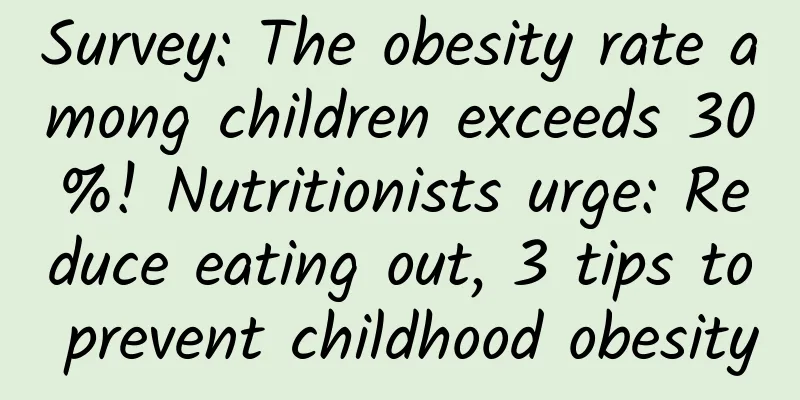Survey: The obesity rate among children exceeds 30%! Nutritionists urge: Reduce eating out, 3 tips to prevent childhood obesity

|
According to the latest National Nutrition Survey conducted by the Ministry of Health and Welfare, the prevalence of overweight and obesity among the 7-12, 13-15 and 16-18 age groups in Taiwan reached 26.7%, 30.6% and 28.9% respectively, indicating that the problem of overweight and obesity among children and adolescents is becoming increasingly serious. A 12-year-old fifth grade student was recently accompanied by his parents to the China Medical University Hsinchu Hospital due to obesity. After being measured by the weight loss center's instruments, his weight was 84.7kg. His BMI and body fat percentage were 33.5 and 37.7% higher than the standard, respectively. After questioning by nutritionist Zhong Jieying, it was revealed that the child seldom exercised, used 3C products for a long time, went to bed late, and had the habit of eating instant noodles and potato chips for midnight snacks, which led to his rapid weight gain recently. After communicating with the parents of the students, a balanced diet was decided: the staple food should be mainly protein, the habit of late-night snacks should be eliminated, and the amount of water consumed should be increased to 3000c.c., 40 minutes of exercise should be done every day, and bedtime should be at 9 o'clock. It is hoped that the goal of controlling BMI and body fat percentage below 21.5 and 27% respectively can be achieved. Nutritionist Zhong Jieying observed that currently Taiwanese students go to daycare or cram school after school, resulting in most students having dinner at convenient eat-out places such as food stalls and convenience stores. Students often want to choose their favorite food or save pocket money, so their food choices are mostly bread, microwave food, braised pork rice, etc., which are unbalanced in nutrients. Most of the food they eat out is refined starch and highly fried food, which leads to excessive calorie intake. In addition, with the rise of 3C products, students have increased their screen time, which in turn reduces dynamic activities and sleep time. Therefore, it is recommended that students who want to have their three meals in convenience stores should mainly eat original foods, such as sweet potatoes, tea eggs, etc., and snacks can be yogurt with fresh fruits. On the eve of Children's Day, nutritionist Zhong Jieying reminded parents and children to master three key factors to prevent obesity. (Photo courtesy of China Medical University Hsinchu Hospital) 3 tips to prevent childhood obesityOn the eve of Children's Day, nutritionist Zhong Jieying reminded parents and children to master three elements to prevent obesity: 1. Increase nutritional knowledge: Cultivate children's understanding of the six major types of food and nutrients from an early age, and inform them of the importance of a balanced diet. Each type of food is indispensable, so as to avoid picky eating and unbalanced nutrient intake. 2. Parents set an example: Obesity-related surveys around the world have found that if children grow up in a family with a healthy diet, they are less likely to suffer from obesity and chronic diseases. This is because parents usually do not choose foods such as sugary drinks and desserts, so children naturally have fewer opportunities to choose such foods on their own, thereby achieving good weight control. 3. Eating and exercising at home: Cooking more often at home can reduce children's intake of excessive fat and calories from eating out. It can also allow children to participate in the meal preparation process, which can motivate them to eat healthily and enjoy eating at home. In addition, exercising together as a family can also increase children and adolescents' willingness to participate in outdoor activities, increase calorie consumption, and achieve the benefits of preventing weight gain and weight control. Nutritionist Zhong Jieying said that according to the latest national nutrition survey statistics from the Ministry of Health and Welfare, the prevalence of overweight and obesity among the 7-12, 13-15 and 16-18 age groups in Taiwan reached 26.7%, 30.6% and 28.9% respectively, indicating that the problem of overweight and obesity among children and adolescents is becoming more serious. Parents are reminded to pay attention to changes in their children's height and weight. If there are any abnormalities in the physical examination form issued by the school, they should start to change their lifestyle or consult a doctor or nutritionist. 👉Recommended reading: Childhood obesity is related to mothers’ “lack of this one action”! Nutritionist Cheng Hanyu teaches how to serve food in 30 minutes 👉Recommended reading: Childhood obesity may lead to complications of cardiovascular disease and fatty liver! Pediatricians teach 9 ways to beat childhood obesity |
Recommend
Experts analyze the four major causes of cervical erosion
It is understood that many female friends will ha...
Drink unsweetened soy milk 30 minutes before meals to increase satiety
With the arrival of the long summer vacation, chi...
Healthy life should be good at preventing cervical hypertrophy
In order to avoid the harm of cervical hypertroph...
Analysis of the success rate of medical abortion
Experts say that some women first think of artifi...
Best treatment for bacterial vaginosis
I believe that many friends are familiar with bac...
What to do if you have poor physical condition after menopause at the age of 39
The physical condition of a 39-year-old woman aft...
Lose weight to fight aging first! 4 keys to regain your slim figure
Why can’t I lose weight? Obesity is the number on...
What tests should I do if I have uterine effusion?
Uterine effusion is mainly caused by inflammatory...
What does multiple uterine fibroids mean? What causes polyps in the uterus?
What does multiple uterine fibroids mean? What ca...
Will medical abortion cause heavy bleeding? See what the doctor says
Medical abortion is a very common abortion treatm...
The occurrence of adnexitis is closely related to unhealthy lifestyle
Adnexitis is a common gynecological disease, and ...
The best hospital for the treatment of endometrial thickening
Currently, the most effective treatment for endom...
What to eat for irregular menstruation?
Irregular menstruation is also called irregular m...
Treat bitterness as tonic! Bitter Melon Enzyme Juice Helps Lose Weight
The active ingredients in bitter melon can inhibi...
Jessica Simpson walks 10,000 steps and loses 30 kg
Jessica Simpson, an American singer and fashion d...









